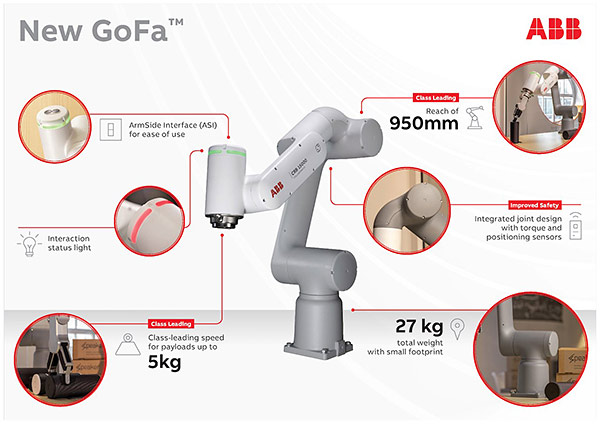ABB yesterday announced that its new GoFa collaborative robot has won the Red Dot “Best of the Best” design award in recognition of its approach to making robotics appealing and accessible to users.
The global Red Dot Design Awards recognize achievements in product design, with the jury assessing thousands of entries every year. The Best of the Best award is for groundbreaking design and is the highest award in the competition, reserved for the most aesthetically appealing, functional, smart or innovative design.
Zurich-based ABB Group is a leading automation, electrification, and software provider, with more than 105,000 employees in over 100 countries. ABB Robotics has more than 100 locations and has U.S. facilities in Auburn Hills, Mich. “GoFa” is named after the idea of helping customers go farther with robotics.
ABB designs GoFa for ease of use, safety, productivity
ABB directed its product designers to create a cobot to encourage people, particularly first-time users, to confidently use and interact with robots.
“Making robots more approachable, easier to use, and more intuitive is key to our vision to make robots as familiar in the workplace as a laptop is today,” stated Sami Atiya, president of ABB’s Robotics & Discrete Automation business. “I am delighted that our new cobot GoFa has been recognized by the Red Dot jury for how user-friendly it is.”
“GoFa is a game-changer, reinforcing the importance of good industrial design to make it easier for more people to work with robots,” he added. “Creating an approachable design will ensure robots are adopted across a range of workplaces outside traditional factory environments, helping us to unlock automation for new users and new industries around the world.”
Design echoes consumer products
ABB Robotics claimed that GoFa’s design is a departure from the look of traditional industrial robots, narrowing the boundaries between industrial and consumer products. Slim, straight arms give the cobot a user-friendly yet strong appearance, while the use of color, materials, and finish gives GoFa a modern, sleek look, said the company.
In addition, GoFa's arm-side interface design with two buttons and light ring echoes the interfaces of consumer products. This makes it accessible even for first-time robot users who may be unfamiliar with industrial machinery, said ABB.
“Industrial design is not just about the aesthetic!” said Andie Zhang, global product manager for collaborative robotics at ABB Robotics. “Form follows function, and our emphasis on human-centric design, using the approach of a consumer product means GoFa communicates the proposition of usability, utility, and ease of use.”
“Creating an attractive, approachable design allows people to get the best out of their cobots,” Zhang said. “We not only want people to feel comfortable working alongside it; we [also] want users to enjoy working with the robot. GoFa is programmed by touching the robot’s arm and leading it, so it’s important that users are comfortable with holding and guiding the cobot as they teach it.”
ABB expands cobot portfolio
ABB released GoFa CRB 15000 in February along with its SWIFTi, a collaborative version of the IRB 1100 industrial robot. They build on the technology of the company’s dual-armed and single-armed YuMi cobots. YuMi won the Best of the Best Red Dot Award in 2011 and was released in 2015.
The six-axis GoFa has a reach of 950mm (37.4 in.) and a payload capacity of 5kg (11 lb.), and it can move up to 2.2 meters per second.
ABB said GoFa is the fastest cobot in its class and is intended to work continuously alongside humans, without the need for fences, on a wide range of tasks. Its advanced safety features include sensors in each joint that can bring the robot arm to a stop in milliseconds if it senses any unexpected contact.
The robot is also designed so that customers do need to rely on robotics programming specialists. The goal is to help businesses with little automation experience operate their cobots shortly after installation with no extra training.
“With their ease-of-use digital tools, integrated safety features, and higher payloads, our new cobots represent the future of human and robot collaboration,” Zhang said. “This next generation will enable even more businesses to automate repetitive, mundane and dangerous processes, to enhance productivity and flexibility while leaving employees free to do more value-add activities. If you can use a tablet or smartphone, you can work with our cobots.”
Article topics
Email Sign Up

















